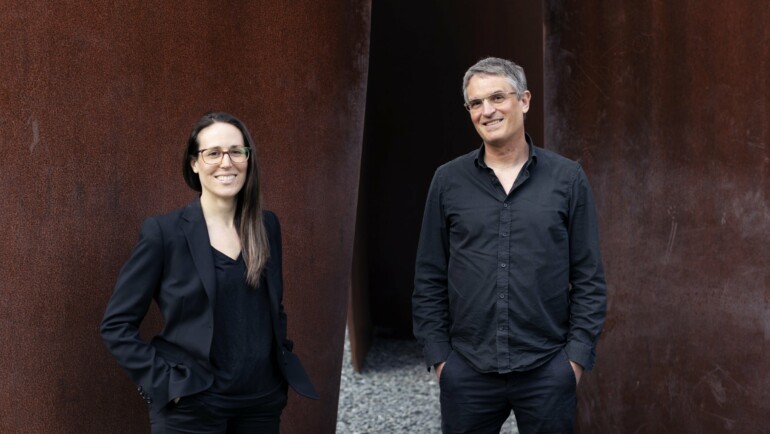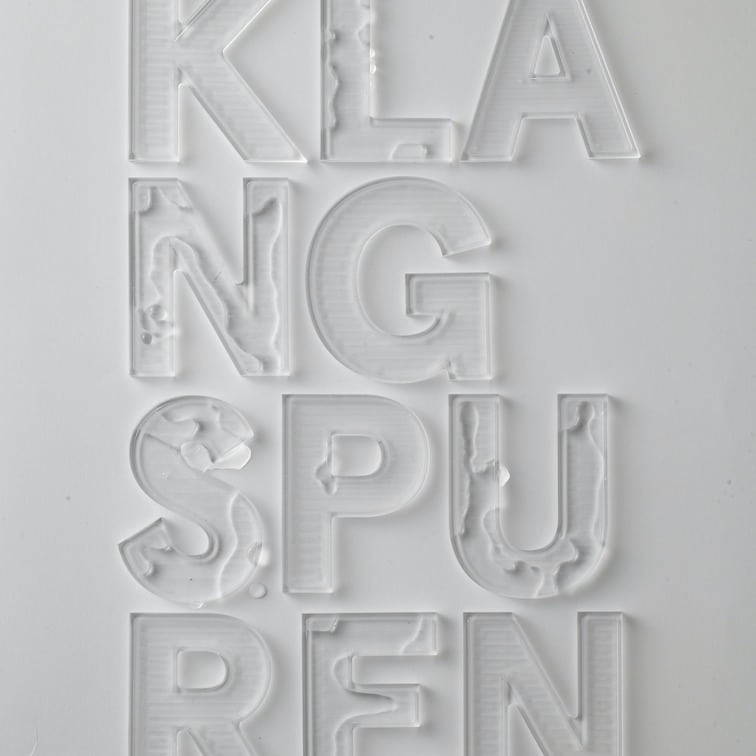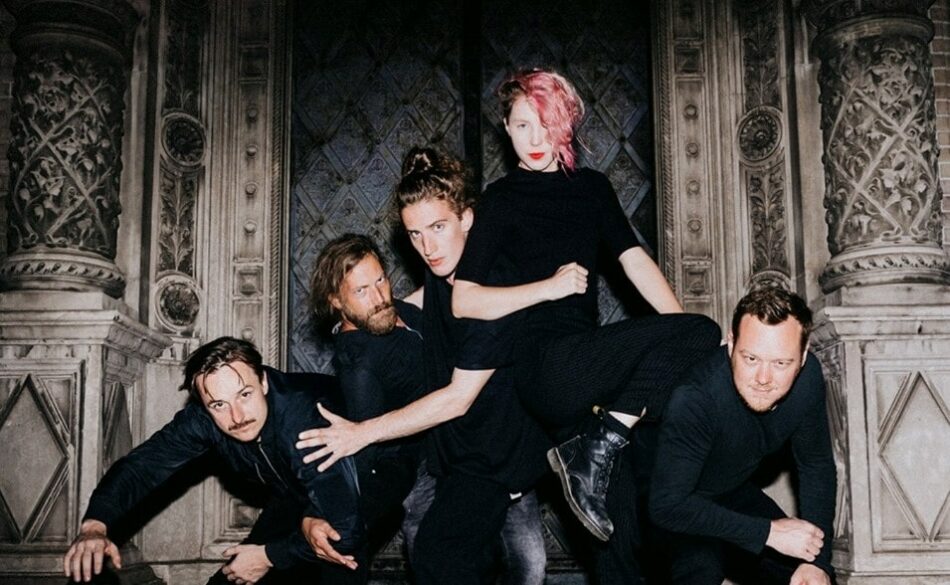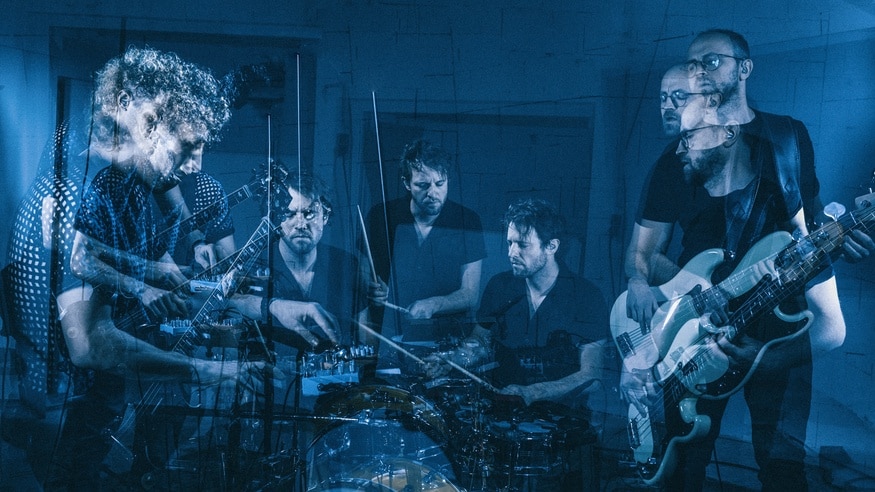
The Tyrolean festival for contemporary music KLANGSPUREN SCHWAZ started its 29th round on September 8th and goes till the 25th. Now, after a rather short-lived change of artistic directors, is made up of two since May 2021: composer and curator CLARA IANNOTTA and composer and multi-instrumentalist CHRISTOF DIENZ. The festival’s focus on reaching new audiences is met by the artistic director duo with a fresh brand: the Future Lab.
How did it come about that the two took charge of the Klangspuren Schwaz festival?
Christof Dienz: Thomas Larcher took over the chairmanship of Klangspuren Schwaz two years ago and asked me who should be the artistic director. My answer was: a woman. I suggested Clara Iannotta because she is so well connected internationally. But the condition for the artistic director was to be here, locally. So we considered the combination of a joint directorship. I am very well connected here in Tyrol and in the Austrian music scene, and I know the edges of new music quite well, which I, personally, would like extend past the academic realm and the so clearly self-defined ‘new music scene’.

And how did you find a common direction – a focus – for this year’s festival?
Clara Iannotta: Although we know each other, we have never worked together before. So it was first important to find an aesthetic common ground. We are very different, so we focused on composers or artists who work in an in-between. Often they are composers and performers, at the same time, and move on a blurred border between aesthetics. Christof himself is also not only a composer but also an instrumentalist. And there are several artists of this kind: Jennifer Walshe, for example, and Matthew Shlomowitz, who will perform her piece “Minor Characters”; also 5K HD, etc. First, we explored the blur between our differences. This was quite exciting and represented our approach to creating our first festival program together.

Was encounter possibly a conscious or unconscious leitmotif? There are often encounters in the concerts: between very old and very new music, between established and very young composers, between art song and orchestral music …
Clara Iannotta: We discussed a lot whether we needed a motto or theme, and came to the conclusion that we didn’t want to have one in our first year of joint festival direction. Nevertheless, there is something that connects the whole program; for example, the visual presence at the beginning and at the end of the program like a framing. In the middle of the program, we go back in time with Eva Reiter playing music of the Baroque on old instruments, or Chaya Czernowin’s vocal piece “Immaterial,” which she herself calls “Madrigal”. We didn’t want to depict just one thing, rather we wanted to create a festival that shows the differences, the multiformity, also the interdisciplinary nature within contemporary music, and thereby give it a meaning and a direction; to explore all the possibilities that new music offers. Young composers are extremely important for this. That is why it is so important to open the festival to them. New music has developed so much and is no longer a self-contained category.
That’s why the “Future Lab” – as the new brand of the “Klangspuren Academy”?
Clara Iannotta: Klangspuren has a long tradition of educational projects such as the “International Ensemble Modern Academy” (“IEMA”), which formed a large part of the festival. We now wanted to do something different. So we created the first “Composers Academy” and the “Chamber Music Lab”.
“MY HOPE IS TO GIVE YOUNG MUSICIANS AN INITIAL EXPERIENCE THAT STRENGTHENS THEM IN WANTING TO BECOME MUSICIANS.”
Christof Dienz: And “konsTellation plus” is an alternative to the “IEMA” that existed for many years at Klangspuren. It worked with great international musicians, but didn’t reach the local scene here. Involving the young musicians of the region was very important to me; after all, there is a conservatory in Innsbruck whose ensemble KONStellation is led by Ivana Pristašová – violin professor at the conservatory and violinist with PHACE. My approach was to use the local resources and offer them a platform that they would not have without the festival, if only for financial reasons. On the one hand, there are concerts they can put on, and on the other, make contact with international musicians and get the opportunity to collaborate with them. My hope is to give young musicians an initial experience that strengthens them in wanting to become musicians. Every musician has such an experience in his or her biography. We also work together with the music high school in Innsbruck. Their younger students are responsible for the sound walk. Working out a program with them was a lot of fun. We even commissioned the 17-year-old composer Mailin Hartlieb from the music high school to write a piece that will be premiered at the Klangwandwanderung. In this way, we create experiences for young people that we hope they won’t soon forget and inspire them to keep going. We are expanding the KONStellation string ensemble to include wind instruments and professors from the Conservatory to deliver the highest level possible. We owe this to the audience and to ourselves, and it should also be an incentive for the students.
The “Recycling Concerto” by Gregor Mayrhofer will then be performed alongside works by Charles Ives, Jörg Widmann and Justė Janulytė.
Christof Dienz: This is a piece for percussion, for waste and ensemble. The focus on the environment is highly topical and is given a witty treatment here.
Clara Iannotta: It is hopefully also exciting for these very young musicians to gain access to works by living composers, since they spend most of their time playing works by dead ones. And also the aspect of making music with anything might be an important experience.
Are all premieres commissioned by the festival?
Christof Dienz: All world premieres are at least co-commissions or even individual commissions from Klangspuren. The Riot Ensemble from London is responsible for the “Composers Lab” as Ensemble in Residence. Young composers work with them for a week on their pieces and then perform them. In addition, the Riot Ensemble presents a concert with works from its repertoire, with which it introduces itself.
Clara Iannotta: We got the roles as directors of the festival in May 2021 and composers sometimes take more than a year to write a piece. With this in mind, I think we achieved a good mix of world premieres and Austrian premieres. The opening concert was commissioned by Klangspuren, and in the second concert there was a co-commission for “Archora” by Anna Thorvaldsdottir. Commissions were also received, for example, by Martin Brandlmayr, Jennifer Walshe and Matthew Shlomowitz. For the Riot Ensemble, Naomi Pinnock and Alex Paxton received a commission for a work. We tried to make it both possible: to complete a piece, but also to bring it to the place of performance and give it new life.

Is there also an attempt to broaden the field of contemporary music with aspects of pop through 5K HD or jazz and electronic music through Studio Dan, for example?
Christof Dienz: These are all auxiliary terms that don’t really get to the core of the respective music. The Studio Dan project in particular is difficult to grasp because it draws on so many elements. Not least because of the drummer Bernhard Breuer, who also sits on the drums with Elektro Guzzi, it has a tendency towards club music, but the musicians also come from jazz, Karolina Preuschl could be described as a Dada singer with Viennese charm, and the composer and ensemble leader Daniel Riegler also brings in his own character. The title Studio Dan refers to the Zappa record Studio Tan, so Zappa is one of the founding fathers of this ensemble. From this you can see that there are many influences in this ensemble, improvisation, free playing is also important – a nice example of ensembles whose music can almost no longer be classified, at most influences can be described that have an effect on it. This also applies to 5K HD: a quasi pop band has probably never existed at Klangspuren in this form, especially not with a composition commission. Our approach is to commission someone like Manu Mayr, who is not a studied composer, but who is incredibly concerned with sound, aesthetics and electronic possibilities, not to write for symphony orchestras, where there are people who know the apparatus better. But rather that we promote his remarkable own abilities and give him a platform to experiment in his element, in which he is at home, and to create something new.

Notation is a big topic in the “Composers Lab” …
Christof Dienz: Yes, notation plays a very important role. In some pieces of the participants of the “Composers Lab”, sounds are often not given down to the smallest detail, but instead a playing technique or interpretable terms. So in some pieces, in addition to the notation, the sound is also interpretable.
Do we go back to the past in order to get hold of our present?
Clara Iannotta: The connection of composers or artists to history can be extremely significant and exciting. There is then the distinct smell of the past, and one must first look for the new; it is not (yet) given. This morning I read the text Martin Brandlmayr brought to Alex Paxton, one of the very young composers who wrote a piece for the Riot Ensemble: It was about the relationship with pop culture. Jenny Walsh or Martin Shlomowitz also have a relationship to it. After all, it’s important to keep a living connection with the audience. We can’t (yet) perform composers who completely reject the past. It’s better to work with history and find our own way to it. I myself have never related a composition to a text. But whatever helps the composer write a piece is encouraged. Most of today I have been reading a text about George Lewis’ “Memex,” which also refers to the past. Time, history or the past can be read in many of the compositions in this year’s Klangspuren, but each finds a different approach.
Is it possible to find a way out of current conditions through the creation of music, for example when Manu Mayr tries to work with the structures of collapse instead of against them, and in Fausto Romitelli’s “An Index of Metals” in the final concert, melancholy but also euphoria is expressed?
Christof Dienz: The core of Manu Mayr’s work, without me knowing the piece, is to delve into the possibilities of electronic effects and electroacoustic phenomena, especially as a bass player. In his duo schtum, for example, he also works with feedback. And in “Aesthetics of Collapse” he tries to approach dealing with something that is actually rejected, that is, to master a problem and to draw creativity from the mastery. In fact, this then looks like that he formally writes down quite a lot – so small models, large form. But in between there is also free space for the individual musicians, because that’s how the Ensemble 5K HD works. Within the structure, everyone can move a bit, to which the singer Mira Lu Kovacs’ lyrics contribute, on which song structures can be developed. To what extent these song structures will flow into the piece remains to be seen. There are also several notated improvisations in the festival program, but the actual sound will still be developed by the musician.

“YOU MAY NOT CONVINCE EVERYONE. BUT THE ONLY WAY TO REACH LISTENERS IS TO TRUST THEM.”
Is there also an attempt behind this to make new music more accessible?
Clara Iannotta: No, I’m completely against that. Of course we can show access to the important parts of the pieces, but that can’t mean making pieces simpler so that they are easier to understand. We should trust the audience to understand. We don’t have to simplify anything. Extremely complex structures sometimes look totally simple from a distance, whereas supposedly simple things can be very complicated. We gain audience by showing what the scene has to offer. So we have to try to make this scene visible, but also accessible. I remember in 2016 when a very loud piece of mine was to be performed at the packed Walt Disney Concert Hall. I was unsettled, not wanting people to go crazy. So I decided to trust the audience. The moment you expose people to good music, they will understand. Maybe you won’t convince everyone. But the only way to reach listeners is to trust them.
For those very approaches, there are introductory talks at some concerts. What will happen there?
Clara Iannotta: The composers will introduce themselves, tell their story about the respective piece or describe the composition process. There are a lot of young composers who are probably still unknown to the audience. Introducing oneself and one’s working methods in stories builds bridges between the composers and their pieces and the audience. Then compositional ideas can also be better recognized in the piece.
Christof Dienz: It can also be quite everyday things that are interesting for the audience. Again, it’s a way to introduce the audience to the music without having to compromise on the music itself. There was a time in new music when it was “eat or be eaten”! That has changed. And that’s a good thing! Above all, it’s about dialogue and exchange between composers and audience. To this end, we have also come up with a list of questions for the composers – the answers to which will gradually be posted on the website.
Thank you very much for the interview!
links
Translated from the German original by Arianna Alfreds.
